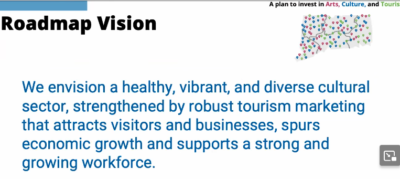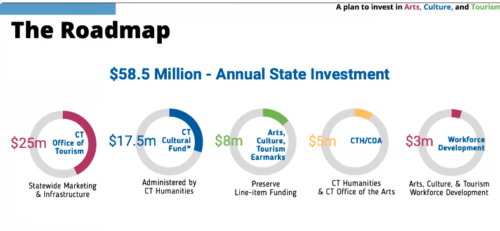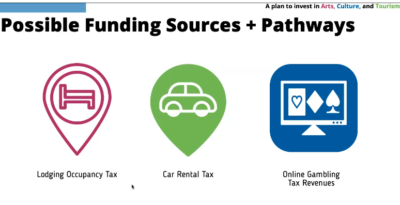
Just last month I wrote a blog about history advocacy:
History Advocacy: Should the History Community Advocate? March 12, 2023
Now there are two prominent examples of good history advocacy and bad or non-existent history advocacy.
GOOD HISTORY ADVOCACY: CONNECTICUT
In Connecticut, there is a funding advocacy project called the Road Map. It is a collaborative initiative by the CT Humanities, the CT Cultural Fund (including Operating Support Grants and Museum Makeover), and the Arts, Culture, and Tourism. The Connecticut League of Historic Organizations (CLHO) also is part of the advocacy effort.

CLHO recently sent out a Legislative Update to its members:
Thank you to everyone who has testified over the past several weeks—in person, virtually, and through written testimony before the CT General Assembly’s Commerce and Appropriations committees on behalf of continued funding for CT Humanities, the CT Cultural Fund (including Operating Support Grants and Museum Makeover), and the Arts, Culture, and Tourism Roadmap.
We are pleased to report that the legislation is slowly making its way through the legislative process. In partnership with CT Humanities, the CT Arts Alliance, and the CT Tourism Coalition, we will continue to provide you with updates about the status of funding for the humanities, arts, and cultural sectors as this year’s CT biennial budgeting process plays out over the coming weeks and months.

This year is a critical one for funding since the budget is a biennial one. As the state heads towards its April 30 deadline for the budget, the advocate partners asked its various members to step up their local efforts.
Now is the time to invite your legislators to your site!
At this time, the best way you, your organization, and your staff, board, and audience can be most helpful is by reaching out to your legislators to:
– thank them for providing funding for the arts, culture, and tourism—and for you and your organization—through the CT Cultural Fund
– tell them how this funding has positively impacted your organization and community
– invite them to your site to have a tour, show them in person what the CT Cultural Fund has enabled you to do and, and help them get to know your organization better
If you can’t schedule a visit, have a phone or Zoom call with them, let them know what you do and why it matters, and talk with them about how the CT Cultural Fund money you’ve received has positively impacted your work and the way you serve your community. Be specific and compelling—tell your story!—and ask them to support the Arts, Culture, and Tourism Roadmap request of $57.5 million.
At the end of March, the partners held an online webinar for the final push. Key ideas from that meeting were:
1. We are a powerhouse and need to start acting like one.
2. We need to blanket the legislators with information about the Road Map.
3. Specific line items have been identified – no new taxes or increase in taxes were called for but the percentage of taxes collected in different revenue streams allocated to these groups needs to be increased.

While there is no guarantee that the initiative will prove successful, there definitely are lessons to be learned from the effort.
1. the importance of statewide organizations taking the lead in advocating for funding
2. the benefit of partnerships with similar organizations – when you combine the number of voters associated with one or more of the participating groups, it really does become a voting bloc in the district of every member of the legislature.
3. the necessity of having specific asks.
This is a new undertaking by these Connecticut organizations including the state history organization. Clearly they are headed in the right direction.
BAD HISTORY ADVOCACY: THE NEW YORK STATE MUSEUM
Perhaps it would be better to say no history advocacy rather than to characterize it as bad. The previous advocacy blog examined the 35 state-owned historic sites. While there are multiple friends groups which act on a local level, there is no statewide organization advocating on their behalf. There is such advocacy for the state-owned parks but not for the historic sites.
For the New York State Museum, the situation is a little quirky. The historic sites are part of the Executive branch of the government. The Museum reports to the Board of Regents as do some schools. More important the Regents sets standards for k-12 schools. The Museum is in the same building as the New York State Archives and New York State Library so right away there is an obvious alliance for advocacy. It should be noted that teachers and librarians definitely advocate for themselves but the state organizations seem to get lost in shuffle. There is a very active archives group.
For the Museum, the story is a sad one. Back in 2015, the New York State Board of Regents released a 14 million dollar four year plan to renovate the New York State Museum’s exhibition galleries. According to the plan, there would be 35,000 square feet of new exhibitions, a changeable wall system and new interactive technology and media. The goal was for it to be completed in phases by 2019.
The vision of the renovation was described in the following themes:
– A State of Change: demonstrates New York State’s geographic and geological change through natural and human impact.
– Politics and Prose: presents New York State as a place of debate, dialogue and documentation.
– Emergence of a State: defines New York State through its people, places and events.
– Culture, Community and Context: explores New York State’s people, cities, and culture through topics such as art, music, architecture and beliefs.
– New York in 100 Objects: an exhibition of 100 objects, including objects borrowed from museums across the state that represents the history of New York.
Sounds good, doesn’t it.
Eight years later the New York State Museum was the subject of two articles by columnist Chris Churchill of the Albany Times Union. He reports that the master plan has disappeared from the Museum website. He also writes about the decrepit care and appearance of a variety of different things in the Museum. There is no need to go with the details except to note that the Museum is not a family friendly venue. Churchill compares the State Museum in Albany unfavorably with the Children’s Museum in Saratoga where it is standing room only.
Churchill also shares come of the comments he (or the paper) received in response to his articles. There still seems to be a residue of goodwill in the community for what should be the showcase state museum and tourist destination. Instead it has become a shabby relic to former good times.
One problem is who advocates on behalf of the New York State Museum? It is under the purview of the Board of Regents. Even if there was a statewide friends group on behalf of the Museum, how exactly does one lobby the Board of Regents? The double goals here are not just more money but a new conceptual post-COVID vision of what the state museum should be.
The answer is one doesn’t. The fate of museum is strictly an internal affair. Maybe the harsh publicity from the two articles will spur the powers that be to recognize that there is a major problem and an urgent need to do something. But then again, maybe not.
I offer these two examples of advocacy – a budding statewide collaborative effort in Connecticut and the desperate need for statewide history advocacy in New York. The Connecticut example is a promising work in progress that seems poised to produce results. The New York example demonstrates what can happen when there is no history community mechanism to speak up on behalf of what should be a crown jewel of history museums in the state … except for a newspaper reporter.




